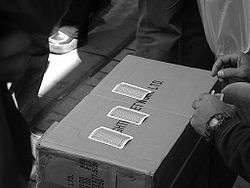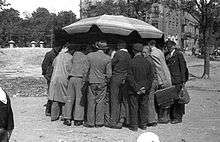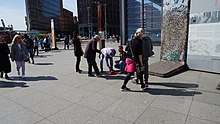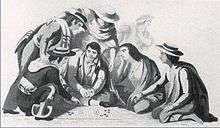Three-card Monte
 | |
| Origin | Spanish |
|---|---|
| Type | Gambling |
| Players | Np. |
| Skills required | Chance |
| Cards | 3 |
| Deck | Any Deck |
| Playing time | 5–10 min. |
| Random chance | Easy |
| Related games | |
| Monte Bank | |
Three-card Monte – also known as find the lady and three-card trick – is a confidence game in which the victim, or "mark", is tricked into betting a sum of money, on the assumption that they can find the "money card" among three face-down playing cards. It is the same as the shell game except that cards are used instead of shells.[1]
In its full form, three-card Monte is an example of a classic "short con"[2] in which a shill pretends to conspire with the mark to cheat the dealer, while in fact conspiring with the dealer to cheat the mark. The mark has no chance whatsoever of winning, at any point in the game. In fact, anyone who is observed winning anything in the game can be presumed to be a shill.
This confidence trick was already in use by the turn of the 15th century.[3]
Rules
The three-card Monte game itself is very simple. To play, a dealer places three cards face down on a table, usually on a cardboard box which provides the ability to set up and disappear quickly.[4] The dealer shows that one of the cards is the target card, e.g., the queen of hearts, and then rearranges the cards quickly to confuse the player about which card is which. The player is then given an opportunity to select one of the three cards. If the player correctly identifies the target card, the player gets the amount bet (the "stake") back, plus the same amount again; otherwise, the stake is lost.
Usual card selection
Since there are only three cards, the jack of spades and jack of clubs often complement the "money card", which is usually a queen.[5] The queen is often a red card, typically the queen of hearts. Sometimes the ace of spades is used as the money card, since in some cultures the ace of spades is viewed as lucky, which might lure the mark into playing the game.
Drawing a player in
When the mark arrives at the three-card Monte game, it is likely that a number of other players will be seen winning and losing money at the game. The people engaged in playing the game are often shills, confederates of the dealer who pretend to play so as to give the illusion of a straight gambling game.[6]
As the mark watches the game, they are likely to notice that they can follow the queen more easily than the shills seem to be able to, which sets them up to believe that they can win the game.
Eventually, if the mark enters the game, they will be cheated through any number of methods. An example of a simple scheme involves a dealer and two shills:

- The dealer and shills act as if they do not know each other. The mark will come upon a game being conducted in a seemingly clandestine manner, perhaps with somebody "looking out" for police. The dealer will be engaged in his role, with the first shill betting money. The first shill may be winning, leading the mark to observe that easy money may be had, or losing, leading the mark to observe that they could beat the game and win money where the first shill is losing it.
- While the mark is watching, the second shill, acting as a casual passerby like the mark, will casually engage a mark in conversation regarding the game, commenting on either how easily the first shill is winning or how they are losing money because they cannot win at what appears to the mark to be a simple game. This conversation is engineered to implicitly encourage the mark to play, and it is possible the second shill could resort to outright encouragement.
- If the mark does not enter the game, the dealer may claim to see police and will fold up the operation and restart it elsewhere, or will wait for another mark to appear on the scene.
- If the mark enters the game, they may be "had" (cheated) by a number of techniques. A common belief is that the operator may let the mark win a couple of bets to suck them in, but this is virtually never true. In a true Monte scam, the mark will never win a single bet, as it is not necessary. There are too many ways for a well-run mob to attract the marks, suck them in, and convince them to put money down.
- When the dealer and the shills have taken the mark, a lookout, the dealer, or a shill acting as an observer will claim to have spotted the police. The dealer will quickly pack up the game and disperse along with the shills.

Methodology

Dealers employ sleight of hand[7] and misdirection to prevent the mark from finding the queen.
While various moves have been devised for Monte, there is one basic move which is overwhelmingly used with virtually all Monte games. It has to do with the way the cards are held and tossed to the table. The dealer will pick up one of the cards with one hand, and two with the other. This is the key: although it appears that the dealer is tossing the lowermost card to the table, in actuality they can toss either the top or the bottom card at will. Thus, having done so, and while mixing up the cards, the mark will be following the wrong card from the beginning. The move, done properly, is undetectable. Even the shills pretending to play are often unaware of where the money card actually is without the dealer employing signals of various kinds to let them know where it is.
Inevitably, once in a while the mark will manage to find the right location of the card by pure chance. This presents no problem at all for the mob; if the mark picks the right card, one of the shills will simply post a higher bid, which the dealer immediately accepts, announcing that they will accept only the highest bid. In other words, the mark puts down money on the right card, at which point a shill will immediately place a double bet on top of the card, thereby winning the "right" to play that round. Of course, if the mark picks the wrong card, the dealer takes the bid and the money. The dealer will never accept a winning bid from a mark.
The psychology of the con is to increase the mark's confidence until they believe they have a special ability to cheat the dealer and win easy money. Everything the Monte mob does is geared towards creating that mindset in the mark. To increase the mark's motivation to bet, they will also employ standard strategies such as having the dealer be slightly abrasive or rude, so there is even more reason to want to take their money.
"Bent corner" variation
The "bent corner ploy" is one of the classic scams in three-card Monte, and is used if the mob thinks a mark can be had for more money, or needs more convincing to put some money down. During the course of tossing the cards, the dealer "accidentally" drops the cards, resulting in a corner of the money card having a slight bend in it. Another variation is for the dealer to look away, and while occupied, one of the shills will quickly put the crimp in the money card. Either way, the dealer pretends not to notice, this perhaps being made more plausible by having the dealer wear thick glasses. Assuming the mark bets on the card with the bent corner, the dealer will tell the mark to turn it over (so there can be no accusations of card-switching), revealing that it is not the money card after all, but one of the loser cards. The dealer has, in the course of tossing the cards, unbent the money card and bent the loser card. In this variation, the mark will be even more reluctant to complain about having lost money, as doing so would reveal that they intended to cheat the dealer.
Solo variation
A skilled card mechanic can perform this con without shills or assistants. Everything is legitimate up until the reveal. To show that nothing dishonest is being done with the selected card, the dealer does not even touch it, using one of the other cards to turn it over. If a losing card was selected, the card is simply turned over. If the winning card was selected, a Mexican Turnover is used to switch the two cards. When done correctly, the two actions are indistinguishable. No matter which card is selected, when turned over it is a losing card.
Variation in card magic
The three-card Monte is performed in card magic tricks with minor or major variations that manipulate the use of gimmick cards, and other sleight-of-hand techniques.
Legality
In Canada, under section 206(1) of the Criminal Code, it is illegal to do the following in relation to three-card monte, which is mentioned by name:
- Receive bets
- Induce any person to stake or hazard any money or other valuable property
- Carry on or play or offer to carry on or play in a public place
- Employ any person to carry on or play in a public place
- Allow the game to take place (the owner of the premises)
They are indictable offences, with a maximum penalty of two years in prison.[8]
History and popular culture
Canada Bill Jones (1820–1877) was considered a master of three-card Monte, in the middle of the 19th century in America.[9]
In 1898, infamous con man Soapy Smith won a sack of gold from returning Klondike miner John Douglas Stewart after several rounds of three-card monte. Smith's associates grabbed the gold and ran when Stewart was reluctant to pay up. A local vigilance committee ruled that Smith should return the gold, but he refused, claiming that Stewart had lost it "fairly". Smith was killed during a shootout with the committee the next evening.[10]
After revealing the secret behind the trick on the British television show How Do They Do That?, American illusionist John Lenahan became the first person to be expelled from the Magic Circle.[11]
The play Topdog/Underdog centers around two brothers who play three card Monte; the climax of the play comes when one brother bets his entire inheritance on one game. The play won the 2002 Pulitzer Prize for Drama.
The film Short Circuit 2 features a three card Monte scam being uncovered by pure chance by the protagonist Johnny 5, who correctly guesses the red card due to his acute vision.
The 1995 film Restoration has a brief three-card Monte sequence that utilizes a double turnover and flushtration (or "back") count. These magician's sleights fail to fool Meg Ryan's character Katherine.
The film Now You See Me 2 features a life-sized version of the three-card Monte performed by Jack Wilder (Dave Franco).
The music video for Run DMC's 1987 song "It's Tricky" features illusionists Penn & Teller trying to scam people by performing the three-card Monte in front of the Rialto Theater in Los Angeles.
In the novel and BBC series Wolf Hall episode "Three Card Trick", Thomas Cromwell learns and utilizes the trick to survive in his adolescent days on the streets in early Tudor-era England, later emphasizing the supremacy of a child doing the trick due to the perceived confidence of prospective players. Cardinal Thomas Wolsey, baffled by his aide's skills at the con, jokingly suggests he teach it to him, should they fall from favor and be put in financial jeopardy.
The film Hearts in Atlantis (2001) features Alan Tudyk as a carney worker performing the three-card Monte to fleece money from the protagonist Bobby Garfield (played by Anton Yelchin). But Bobby had inadvertently absorbed a mind reading ability from Ted Brautigan (Anthony Hopkins's character) and was able to beat the con.
Notes
- ↑ Tom Ogden The Complete Idiot's Guide to Magic Tricks, p. 123, Alpha Books (1998) ISBN 0-02-862707-5
- ↑ https://nypost.com/2014/12/26/three-card-monte-scam-artists-return-to-midtown/ New York Post, Three-card monte scam artists return to midtown, Is this Christmas 2014 – or 1974?
- ↑ Paul B. Newman Daily life in the Middle Ages, p. 169, McFarland (2001) ISBN 0-7864-0897-9
- ↑ Richard John Neuhaus The best of The Public Square, p. 203, Wm. B. Eerdmans Publishing Company (2001) ISBN 0-8028-4995-4
- ↑ Three-card Monte at pagat.com
- ↑ J. Peder Zane "The Sticks, the Slides & the Shaker," New York Magazine, 1989
- ↑ Penn Jillette, radio interview, NPR, ca. 2000
- ↑ Criminal Code, RSC 1985, c C-46, s 206.
- ↑ William Norman Thompson Gambling in America: an encyclopedia of history, issues, and society, p. 205, ISBN 1-57607-159-6
- ↑ Sauerwein, Stan (2005). Soapy Smith: Skagway's Scourge of the Klondike. Heritage House Publishing Co. ISBN 1554390117.
- ↑ Vincent, Matthew (30 March 2012). "Equities: A kind of magic". The Financial Times. Retrieved 9 January 2015.